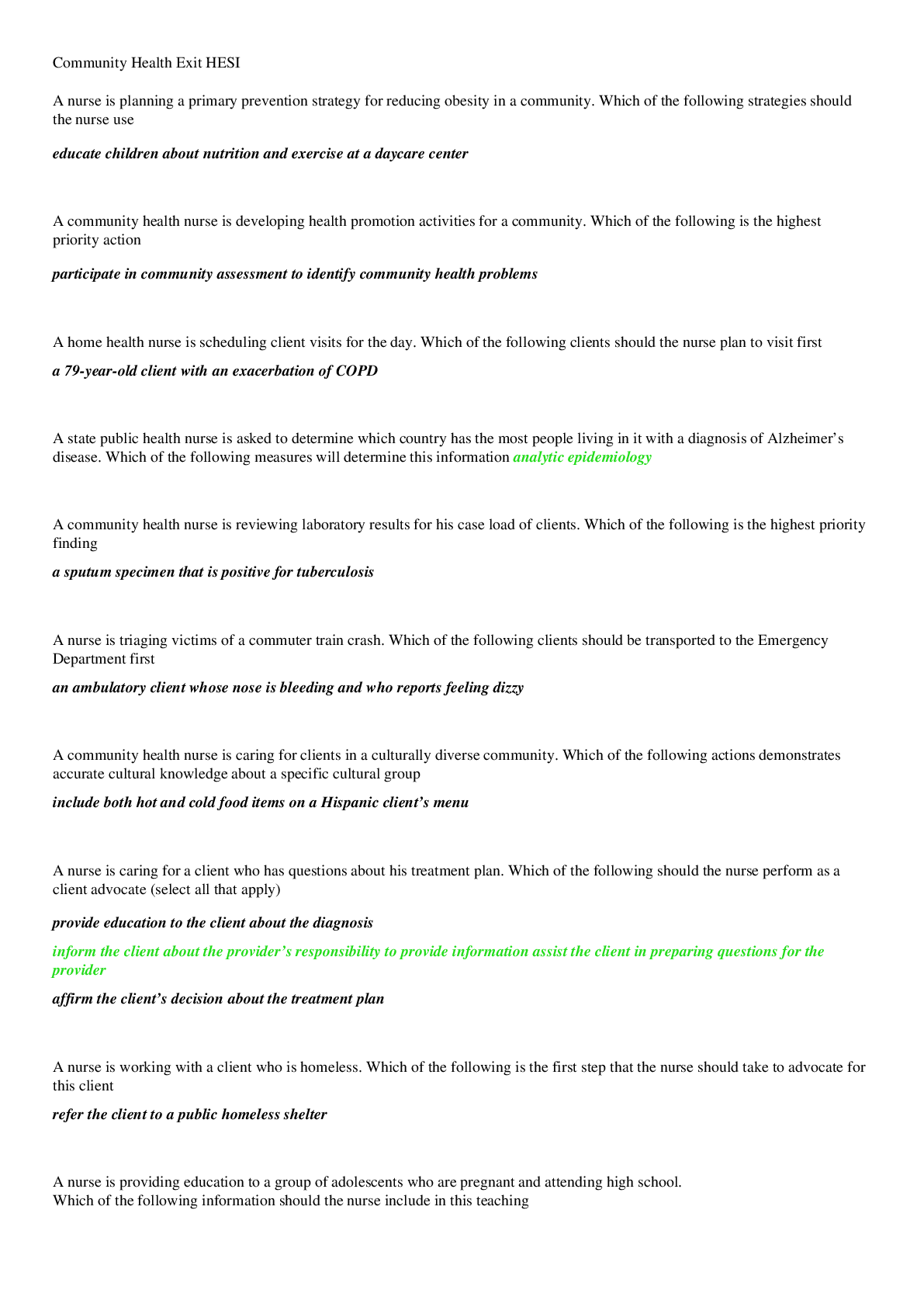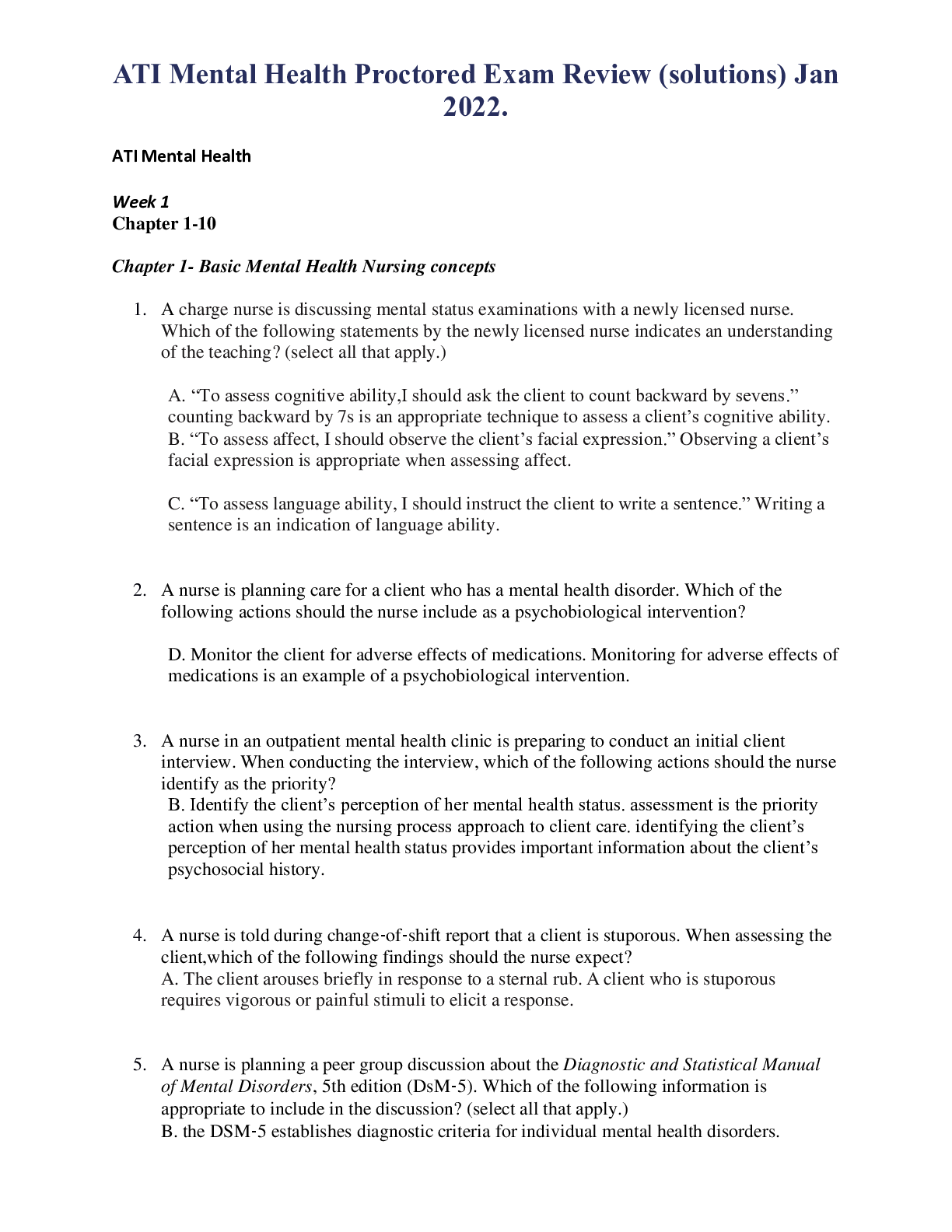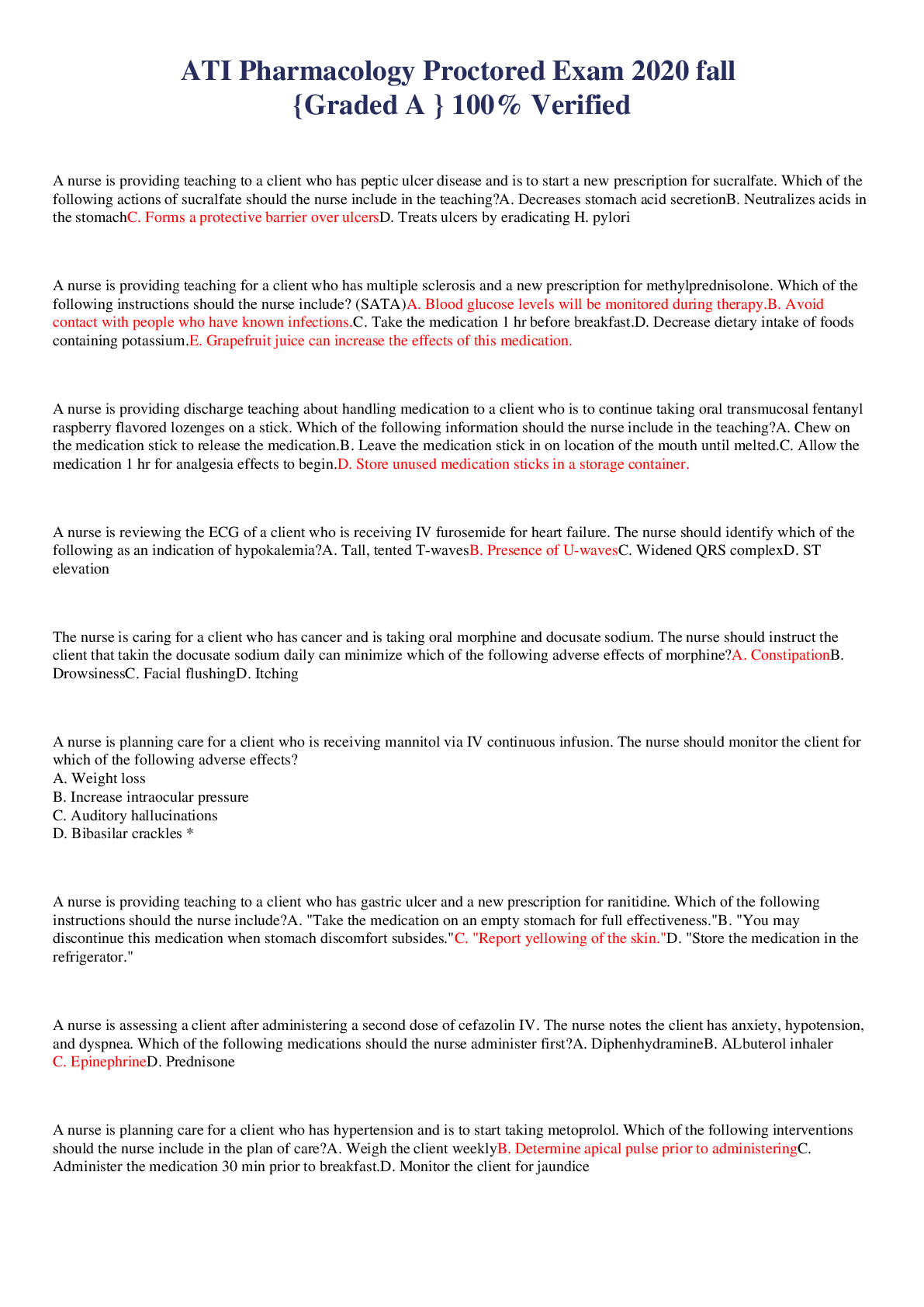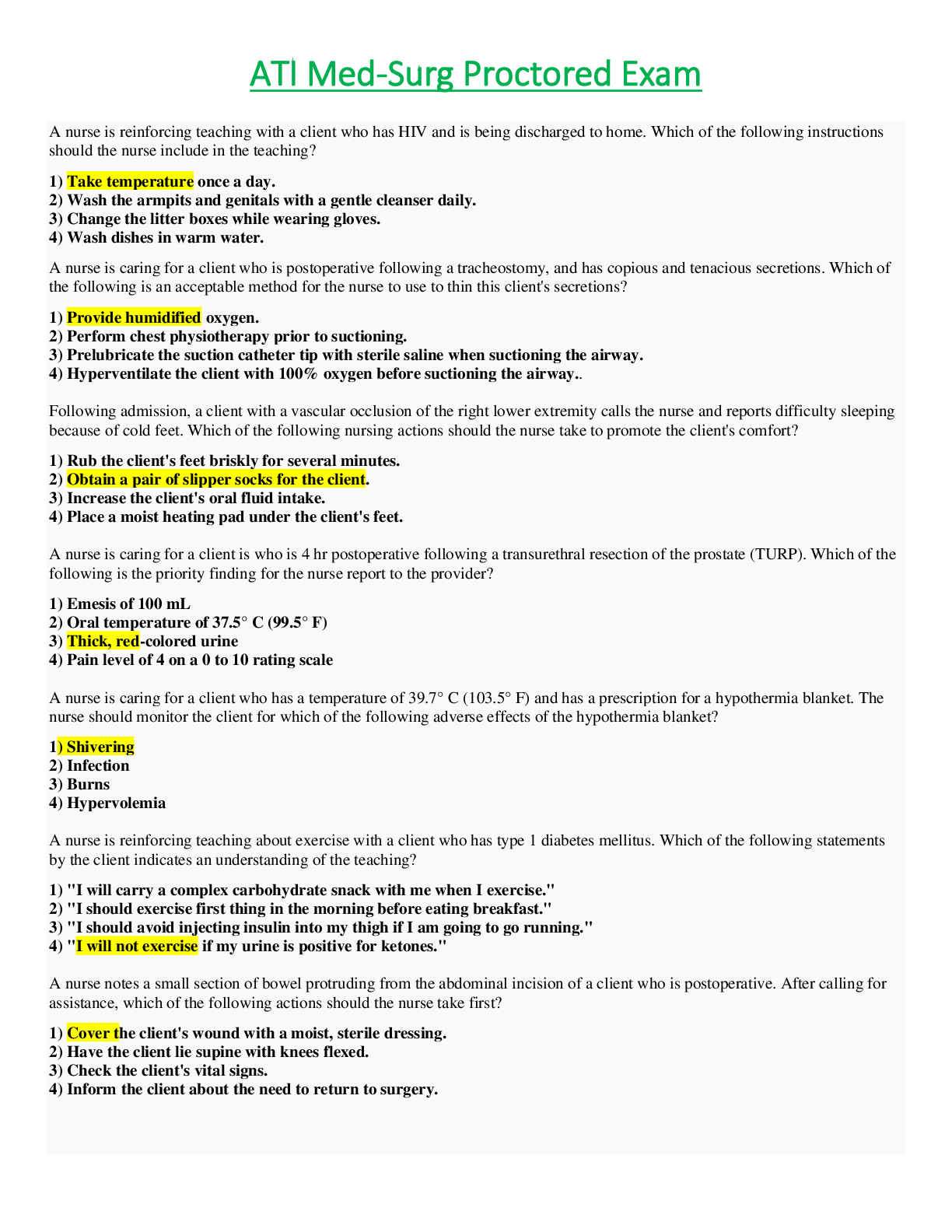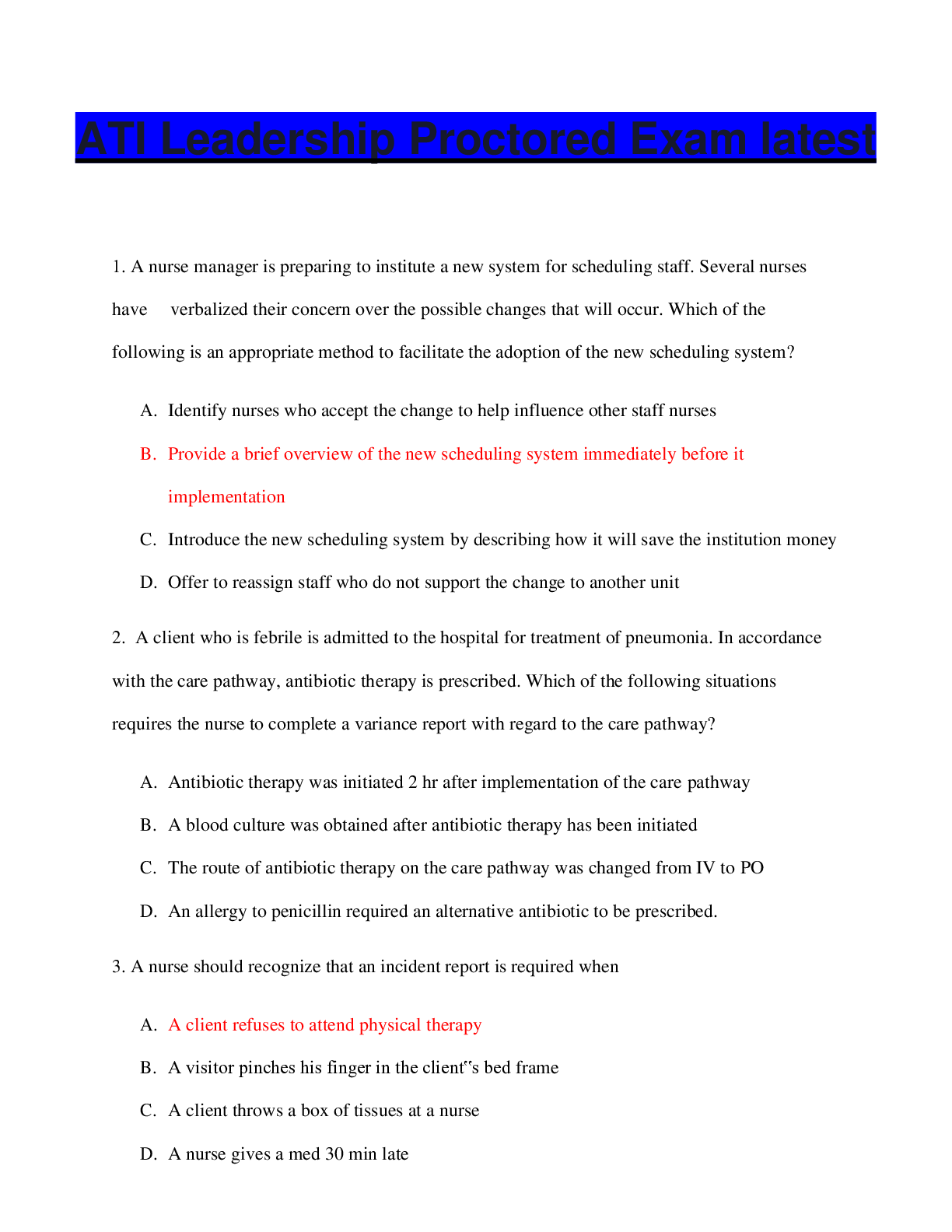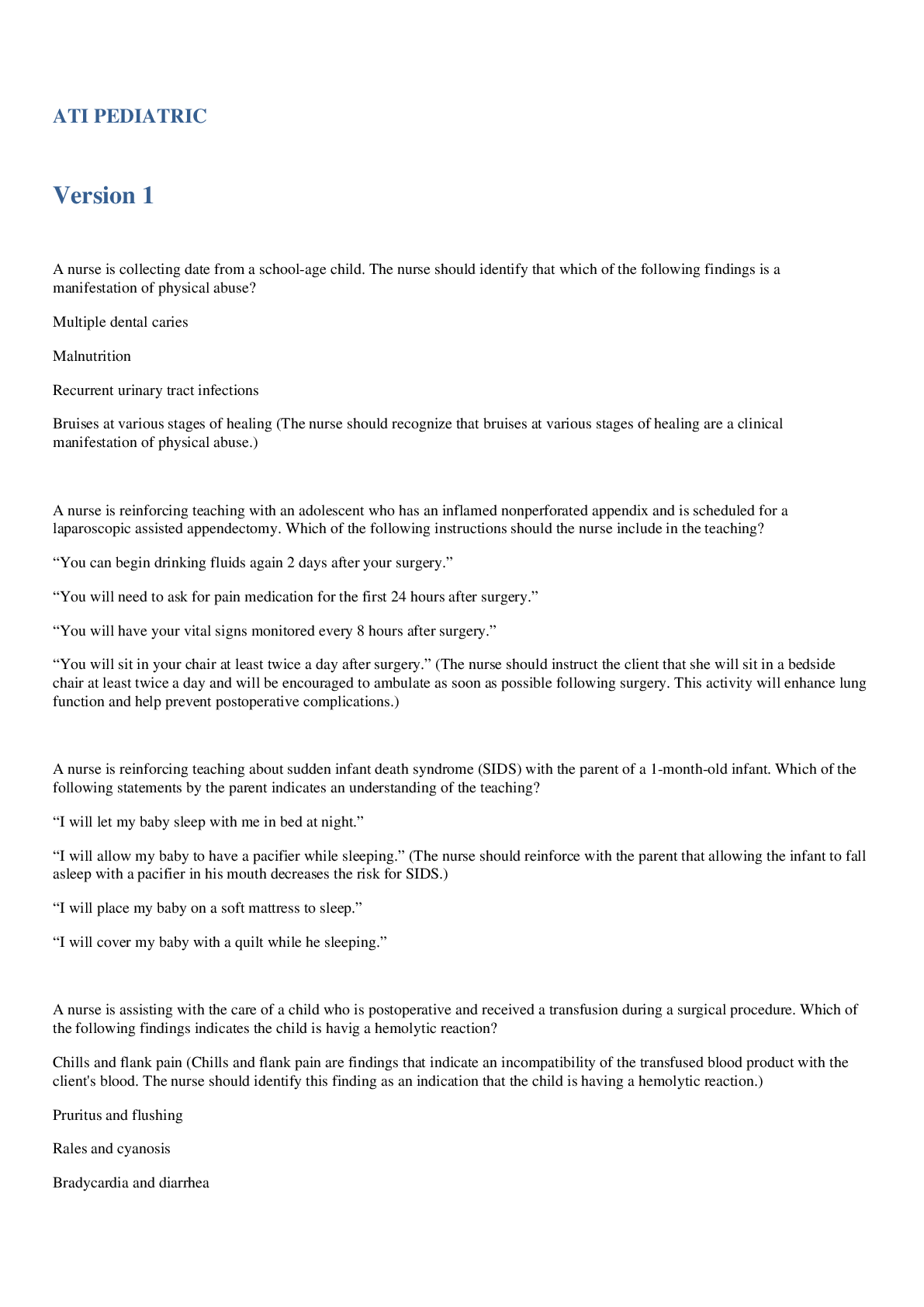*NURSING > EXAM PROCTORED > ATI pediatric Proctored Exam latest and graded A (All)
ATI pediatric Proctored Exam latest and graded A
Document Content and Description Below
ATI pediatric Proctored Exam 1. A guardian calls the clinic nurse after his child has developed symptoms of varicella and asks when his child will no longer be contagious. Which of the following re... sponses should the nurse make? a) “When your child no longer has a fever.” b) “Three days after the rash started.” c) “Six days after lesions appear if they are crusted.” (The nurse should inform the guardian that a child will stop being contagious around 6 days after the lesions appeared, as long as they are crusted over.) d) “When your child’s lesions disappear.” 2. A nurse is reinforcing teaching about sudden infant death syndrome (SIDS) with the parent of a 1-month-old infant. Which of the following statements by the parent indicates an understanding of the teaching? a) “I will let my baby sleep with me in bed at night.” b) “I will allow my baby to have a pacifier while sleeping.” (The nurse should reinforce with the parent that allowing the infant to fall asleep with a pacifier in his mouth decreases the risk for SIDS.) c) “I will place my baby on a soft mattress to sleep.” d) “I will cover my baby with a quilt while he sleeping.” 3. A nurse is collecting date from a school-age child. The nurse should identify that which of the following findings is a manifestation of physical abuse? a) Multiple dental caries b) Malnutrition c) Recurrent urinary tract infections d) Bruises at various stages of healing (The nurse should recognize that bruises at various stages of healing are a clinical manifestation of physical abuse.) 4. A nurse is reinforcing teaching with an adolescent who has an inflamed nonperforated appendix and is scheduled for a laparoscopic assisted appendectomy. Which of the following instructions should the nurse include in the teaching? a) “You can begin drinking fluids again 2 days after your surgery.” b) “You will need to ask for pain medication for the first 24 hours after surgery.” c) “You will have your vital signs monitored every 8 hours after surgery.” d) “You will sit in your chair at least twice a day after surgery.” (The nurse should instruct the client that she will sit in a bedside chair at least twice a day and will be encouraged to ambulate as soon as possible following surgery. This activity will enhance lung function and help prevent postoperative complications.) 5. A nurse is assisting with the care of a child who is postoperative and received a transfusion during a surgical procedure. Which of the following findings indicates the child is havig a hemolytic reaction? a) Chills and flank pain (Chills and flank pain are findings that indicate an incompatibility of the transfused blood product with the client's blood. The nurse should identify this finding as an indication that the child is having a hemolytic reaction.) b) Pruritus and flushing c) Rales and cyanosis d) Bradycardia and diarrhea 6. A nurse is collecting date from a child during a well-child visit. The nurse should recognize that which of the following findings places the child at a higher risk for abuse? a) The child is 6 years old. b) The child is male. c) The child was born at 30 weeks of gestation. (The nurse should identify that children who are born prematurely are at greater risk for abuse because of the potential for impaired bonding during early infancy.) d) The child was born via cesarean birth. 7. A nurse is reinforcing teaching with the guardian of a child who has a new diagnosis of rheumatic fever. Which of the following statements by the guardian indicates an understanding of the teaching? a) “I should not give my child aspirin for pain or fever.” b) “My child will take antibiotic for 6 months.” c) “My child might have a period of irregular movement of the extremities.” (The nurse should instruct the guardian that the child might experience chorea weeks or months after the initial diagnosis. Chorea is a temporary lack of coordination and the presence of sudden, irregular movements or periods of clumsiness.) d) “I should expect there to be blood in my child’s urine.” 8. A nurse is collecting data from an infant during a well-child visit. Which of the following sites should the nurse use when obtaining the infant’s heart rate? a) Apical (The nurse should use the apical pulse to obtain the infant's heart rate and count it for a full minute, because it gives a reliable rate and rhythm and provides accurate baseline assessment data. In an infant, the apical heart rate is auscultated at the fourth intercostal space lateral to the midclavicular line.) b) Radial c) Carotid d) Femoral 9. A nurse is preparing a toddler for suturing of a minor facial laceration. The nurse should place the toddler in which of the following restraints? a) Mummy restraint (The nurse should use a mummy wrap when a short-term restraint is needed for treatment of the toddler that involves the head and neck. The nurse should always use the least amount of restraint necessary.) b) Jacket restraint c) Elbow restraint d) Wrist restraint 10. A nurse is reinforcing dietary teaching with the parent of a 2-year-old toddler. Which of the following should the nurse include in the teaching? a) "It is recommended that the toddler consumes no more than 12 ounces of fruit juice each day." b) "An appropriate serving size is 1 tablespoon of food per year of age." (The nurse should include that an appropriate serving size for a 2-year-old toddler is 1 tbsp of food per year of age.) c) "Introduce healthy finger foods like carrots and celery sticks." d) "Encourage 5 cups of low-fat milk each day." 11. During a well-child visit, the parent of a toddler expresses concern to the nurse that the toddler takes several hours to fall asleep at night. Which of the following recommendations should the nurse make? a) Vary the time the toddler goes to bed each night b) Allow the toddler to watch television before bedtime c) Provide the toddler with a favorite toy at bedtime. (The nurse should recommend to the parent that providing the toddler with a favorite toy at bedtime will help the toddler to feel more secure and facilitate sleep.) d) Increase the toddler's activity prior to bedtime 12. A nurse is assisting with the care for a 7-month-old infant who has a cleft palate. Which of the following actions should the nurse take to decrease the infant’s risk for aspiration? a) Feed the infant in supine position. b) Encourage the mother to breastfeed the infant exclusively. c) Burp the infant frequently during feedings. (Infants with a cleft palate have difficulty creating a seal around a bottle. Burping the infant frequently, following every ounce of fluid consumed, dissipates swallowed air and helps to prevent aspiration.) d) Perform nasotracheal suctioning if coughing occurs 13. A nurse is reviewing the laboratory values of a school-age child who has iron deficiency anemia. Which of the following findings should the nurse expect? a) Hgb 9.0 g/dL (The nurse should expect a child who has iron deficiency anemia to have an Hgb level below the expected reference range of 9.5 to 15.5 g/dL. An Hgb of 9.0 g/dL is below the expected reference range.) b) Hct 37% c) Iron 100 mcg/dL d) Total iron binding capacity 325 mcg/dL 14. A nurse is reinforcing teaching about vital signs with the guardian of a 1-year-old toddler. Which of the following statements by the guardian indicates an understanding of the teaching? a) "My child's pulse could increase to 150 beats a minute with activity.” (A pulse rate of 150/min is within the expected reference range for a toddler during physical activity.) b) "My child's temperature should be 96.8 degrees Fahrenheit." c) "My child should take 40 breaths a minute." d) "My child's pulse could get as low as 60 beats a minute while asleep." 15. A nurse is caring for an adolescent who has acne and anew prescription for isotretinoin. For which of the following adverse effects should the nurse monitor? a) Hypersalivation b) Depression (Clients taking isotretinoin can experience mental status changes, such as suicidal thoughts, aggression, emotional lability, and depression. The nurse should monitor the adolescent's mental status while taking isotretinoin.) c) Bradycardia d) Hyperreflexia 16. A nurse is reinforcing teaching about interventions for mild hypoglycemia with the parent of a child who has diabetes mellitus. Which of the following statements by the parent indicates that the teaching has been effective? a) "I should administer a glucagon injection to my child." b) "I should give my child 5 grams of a simple carbohydrate." c) "I should give my child 4 ounces of orange juice followed by cheese and crackers." (The parent should treat mild hypoglycemia with 10 to 15 g of a simple carbohydrate, such as 4 oz. of orange juice, and follow it with a starch-protein snack.) d) "I should give my child a snack that is 10 percent of his daily caloric intake." 17. A nurse is collecting data from a 10-month-old infant. Which of the following findings should the nurse report to the provider? a) Pulls self to standing position b) Moves by creeping on hands and knees c) Takes intentional steps when standing d) Sits with support by leaning on hands (The nurse should identify that sitting with support can indicate a developmental delay, because an infant should be able to sit unsupported by 8 months of age. Therefore, the nurse should report this finding to the provider.) 18. A nurse is preparing to administer phenobarbital to a toddler who has a seizure disorder and weights 10 kg (22 lb). The prescription reads phenobarbital sodium 2.5 mg/kg PO BID. Available is phenobarbital 20 mg/5 mL. How many mL should the nurse administer with each dose? (Round to the nearest hundredth. Use a leading zero if it applies. Do not use a trailing zero Ratio and Proportion 6.26 mL Step 1: What is the unit of measurement the nurse should calculate? mL Step 2: What is the dose the nurse should administer? Dose to administer = Desired 2.5 mg/kg = 2.5 x 10 = 25 mg Step 3: What is the dose available? Dose available = Have 20 mg Step 4: Should the nurse convert the units of measurement? No Step 5: What is the quantity of the dose available? 5 mL Step 6: Set up an equation and solve for X. Have/Quantity = Desired/X 20 mg/5 mL = 25 mg/X mL X = 6.25 19. A nurse is caring for a child who has type 1 diabetes mellitus and has been receiving insulin via subcutaneous infusion pump. Which of the following laboratory tests would verify the average blood glucose level over the past 2 months? a) Postprandial blood glucose b) Fasting blood glucose c) Glycosylated hemoglobin (Glycosylated hemoglobin provides an accurate average of the client's blood glucose level over the past 120 days. This test can be used to determine the effectiveness of, or compliance with, a treatment plan. It can also be used to diagnose diabetes mellitus.) d) Mean corpuscular hemoglobin 20. A nurse is reinforcing teaching with the guardian of a child who has a new prescription for levalbuterol solution for use in a nebulizer. Which of the following statements by the guardian indicates an understanding of the teaching? a) "I should store the unused medication in the freezer." b) "I should make sure I use the vial within 3 weeks of opening it from the foil package." c) "My child might be drowsy while taking this medication." d) "My child might experience palpitations after taking this medication." (Palpitations are an adverse effect of levalbuterol. If this occurs, the guardian should discontinue the medication and notify the provider. 21. A nurse is collecting data from a 12-month-old infant during a well-child visit. At birth, the infant’s weight was 3.6 kg (8 lb.) and his length was 50.8 cm (20 in). Based on this data, which of the following findings should the nurse expect? a) The infant weighs 6.4 kg (14 lb) b) The infant is 101.6 cm (40 in) long c) The infant is 76.2 cm (30 in) long (The nurse should expect a length of 76.2 cm (30 in), because the infant's length should increase by about 50% by 12 months of age.) d) The infant weighs 14.5 kg (32 lb) 22. A nurse is reinforcing teaching about home care with the guardian of a 14-month-old toddler who has spastic cerebral palsy. Which of the following statements by the guardian indicates an understanding of the teaching? a) "I will perform daily stretching exercises to my toddler's affected muscles." (The nurse should reinforce that performing stretching exercises of the toddler's affected muscles will prevent muscle contractures.) b) "I will ensure my toddler avoids activities that involve repetitive joint movements." c) "I will place my toddler on his stomach to nap after meals." d) "I will give my toddler pain medication just after he performs strenuous activities." 23. A nurse is assisting with the development of a health promotion program for the guardians of adolescents. Which of the following information about adolescents should the nurse recommend to include in the program? a) The sleep patterns of adolescents are well established. b) The percentage of adolescents that consider suicide is higher for males than for females. c) The leading cause of death in adolescents is physical injury. (The nurse should recommend including this information, because injuries from motor-vehicle crashes are the leading cause of death in the adolescent population.) d) The caloric intake needs of adolescents are less than that of school-age children. 24. A nurse in a pediatric clinic is caring for an infant who has heart failure and a prescription for digoxin. Which of the following statements by the parent indicates the desired therapeutic effect of the medication? a) "My baby is breathing easier than she used to." (The nurse should identify that the desired effect of digoxin is to increase cardiac output and decrease venous pressure and pulmonary edema, which will reduce respiratory demands.) b) "My baby is taking longer naps." c) "My baby is having fewer wet diapers." d) "My baby's heart rate is faster than it used to be." 25. A nurse is contributing to the plan of care for a 10-month-old infant who is postoperative following cleft palate repair. Which of the following actions should the nurse include in the plan of care? a) Place the infant in side-lying position. (The nurse should place the infant in side-lying position to promote healing and prevent injury to the surgical site.) b) Offer the infant liquids with a straw. c) Prohibit the guardian from holding the infant for 8 hr. d) Cleanse the suture line with a lemon glycerin swab. [Show More]
Last updated: 1 year ago
Preview 1 out of 5 pages
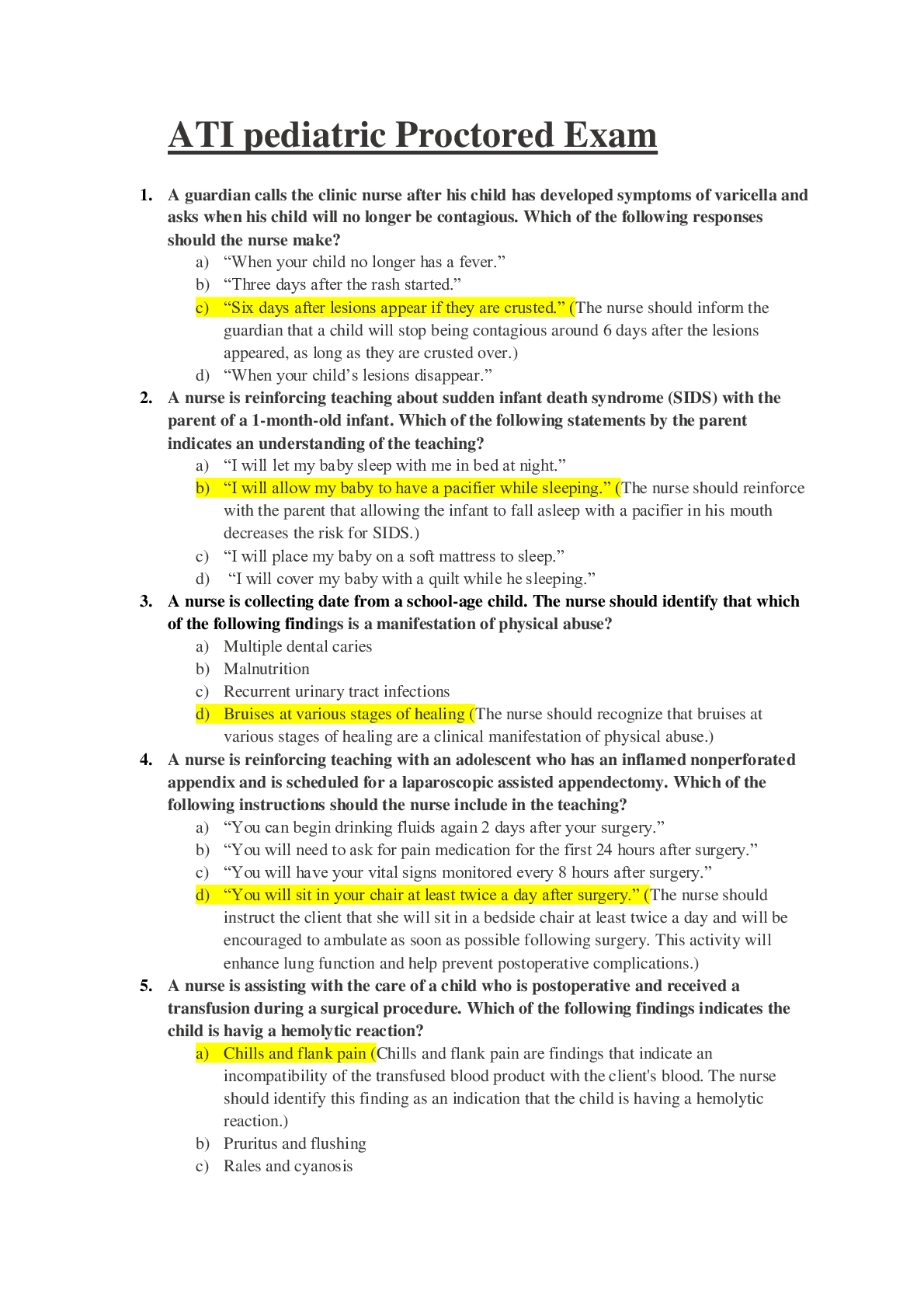
Reviews( 0 )
Document information
Connected school, study & course
About the document
Uploaded On
Sep 09, 2020
Number of pages
5
Written in
Additional information
This document has been written for:
Uploaded
Sep 09, 2020
Downloads
0
Views
162



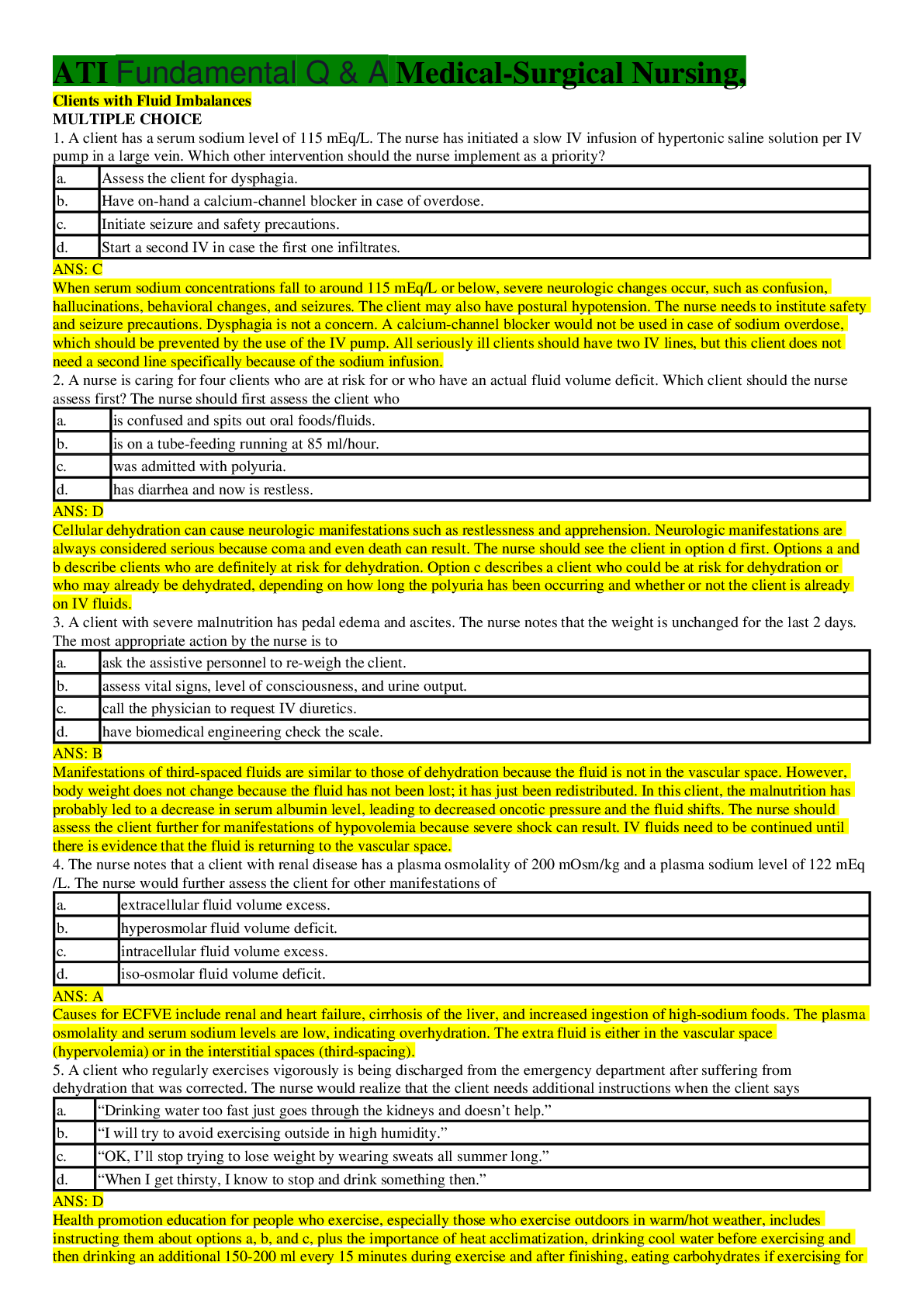
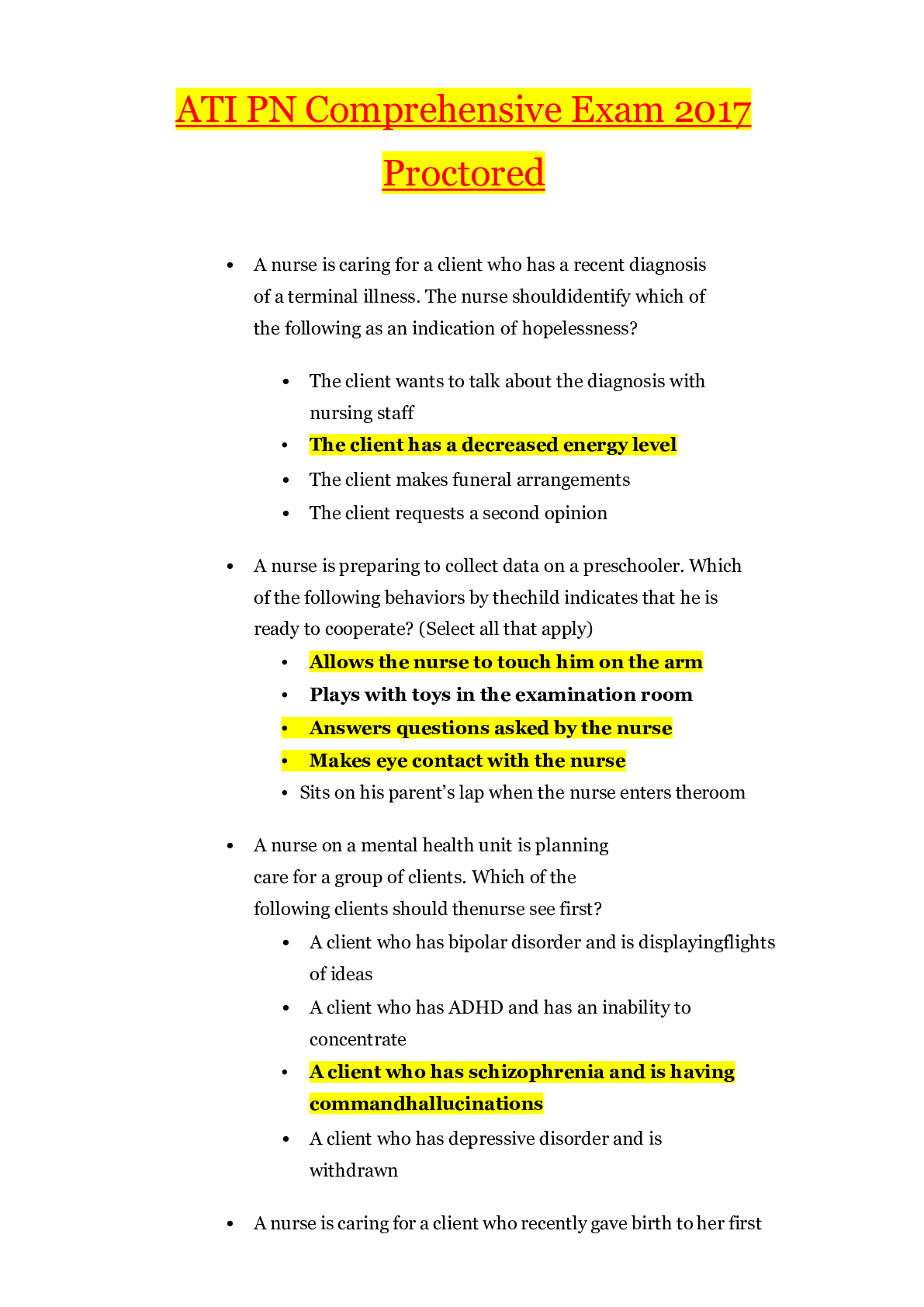
.png)
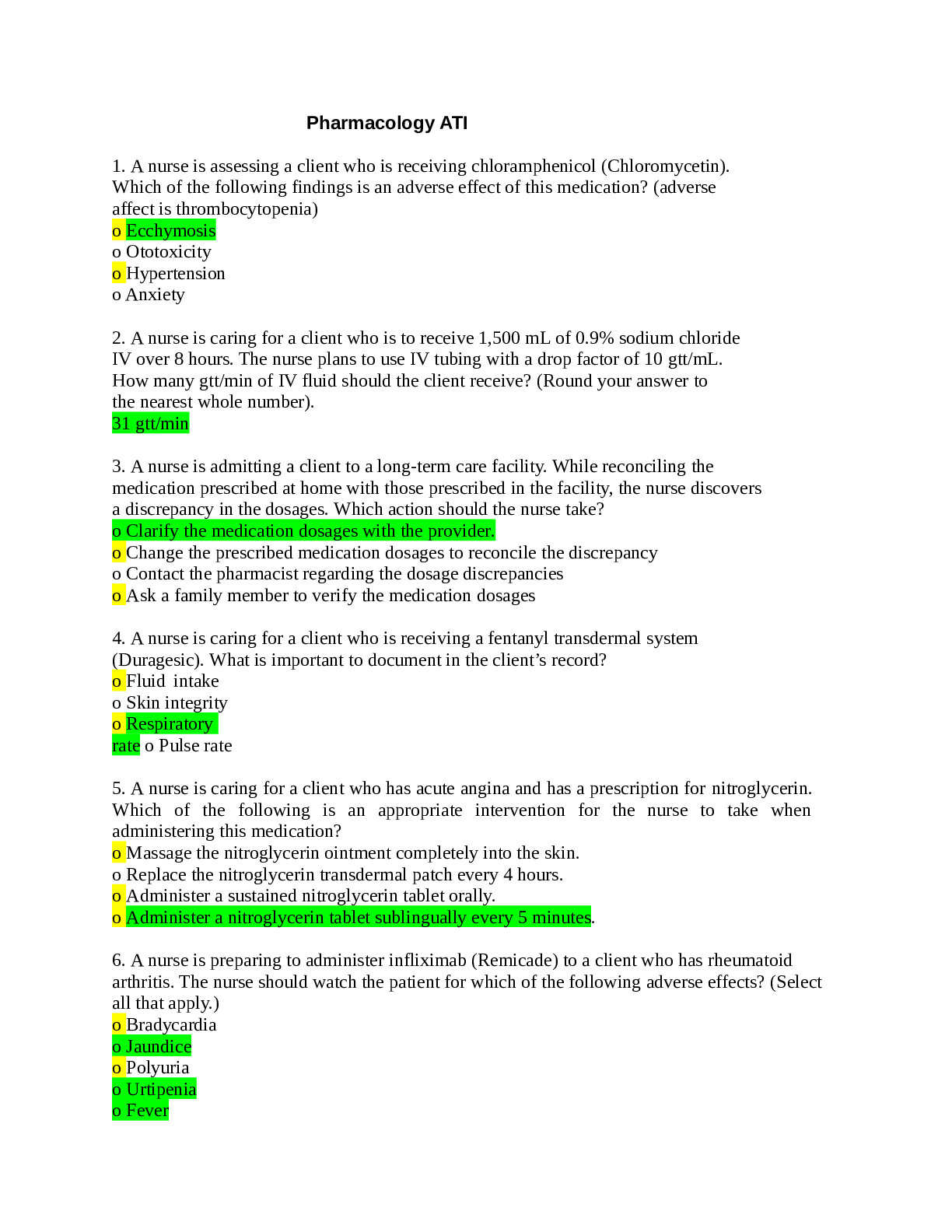
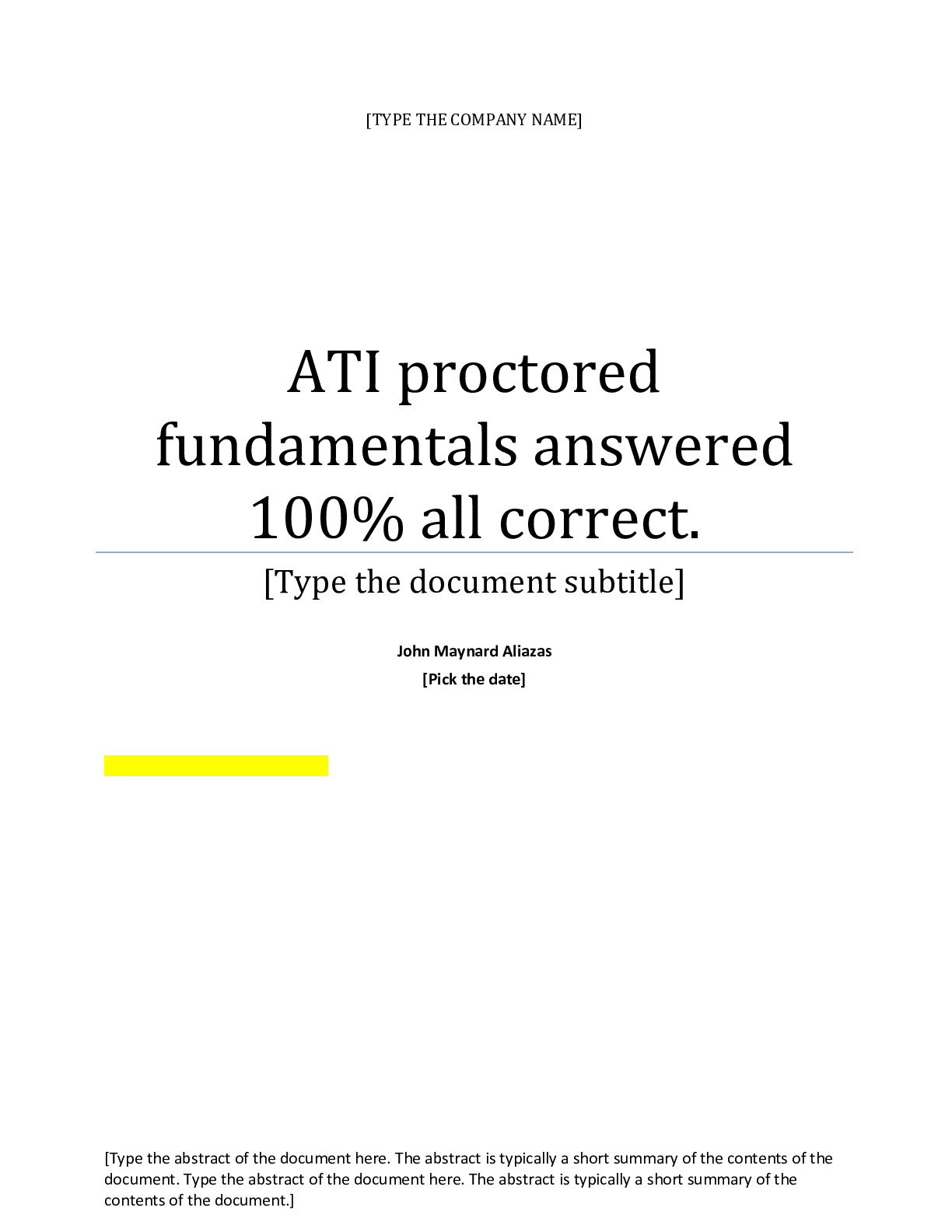
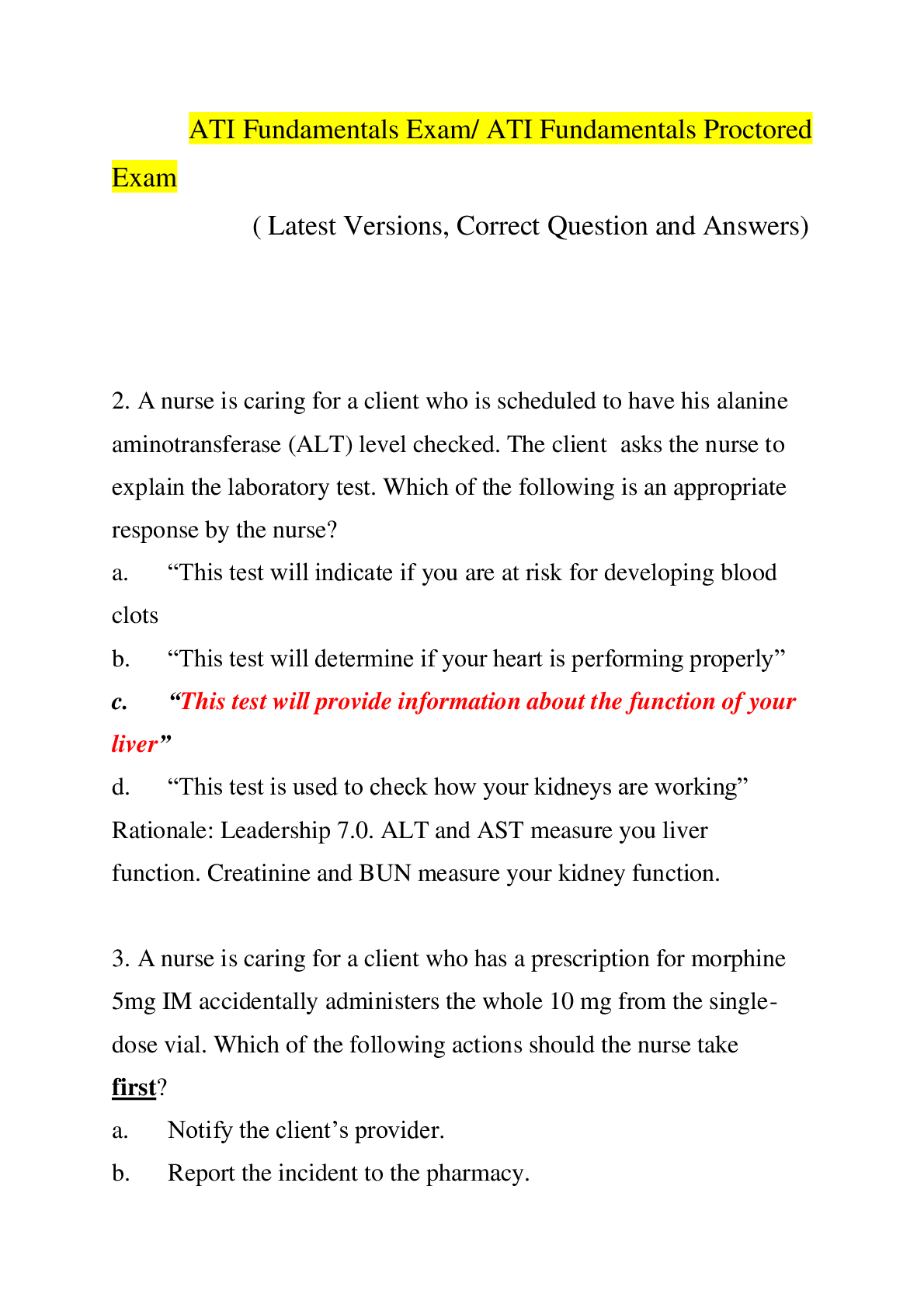

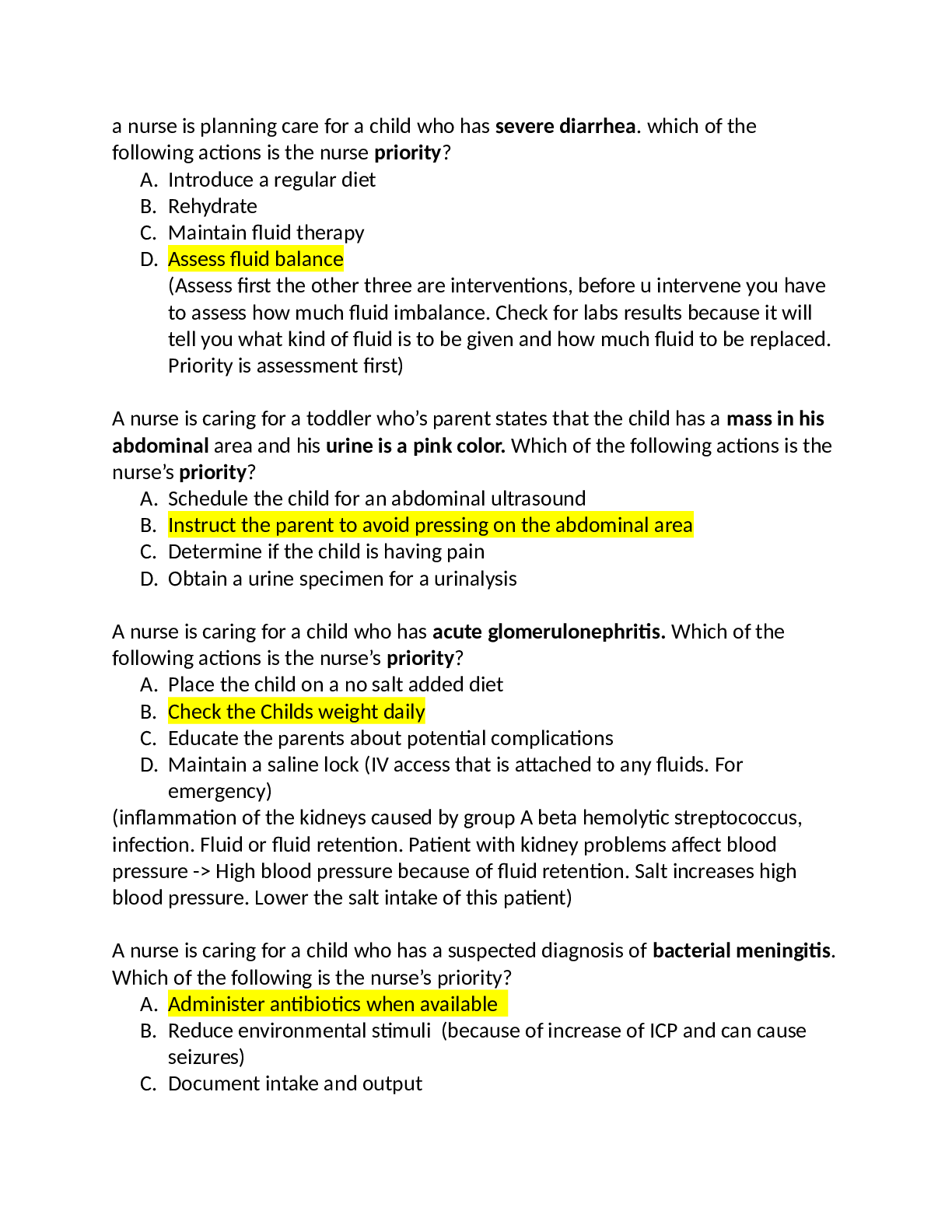
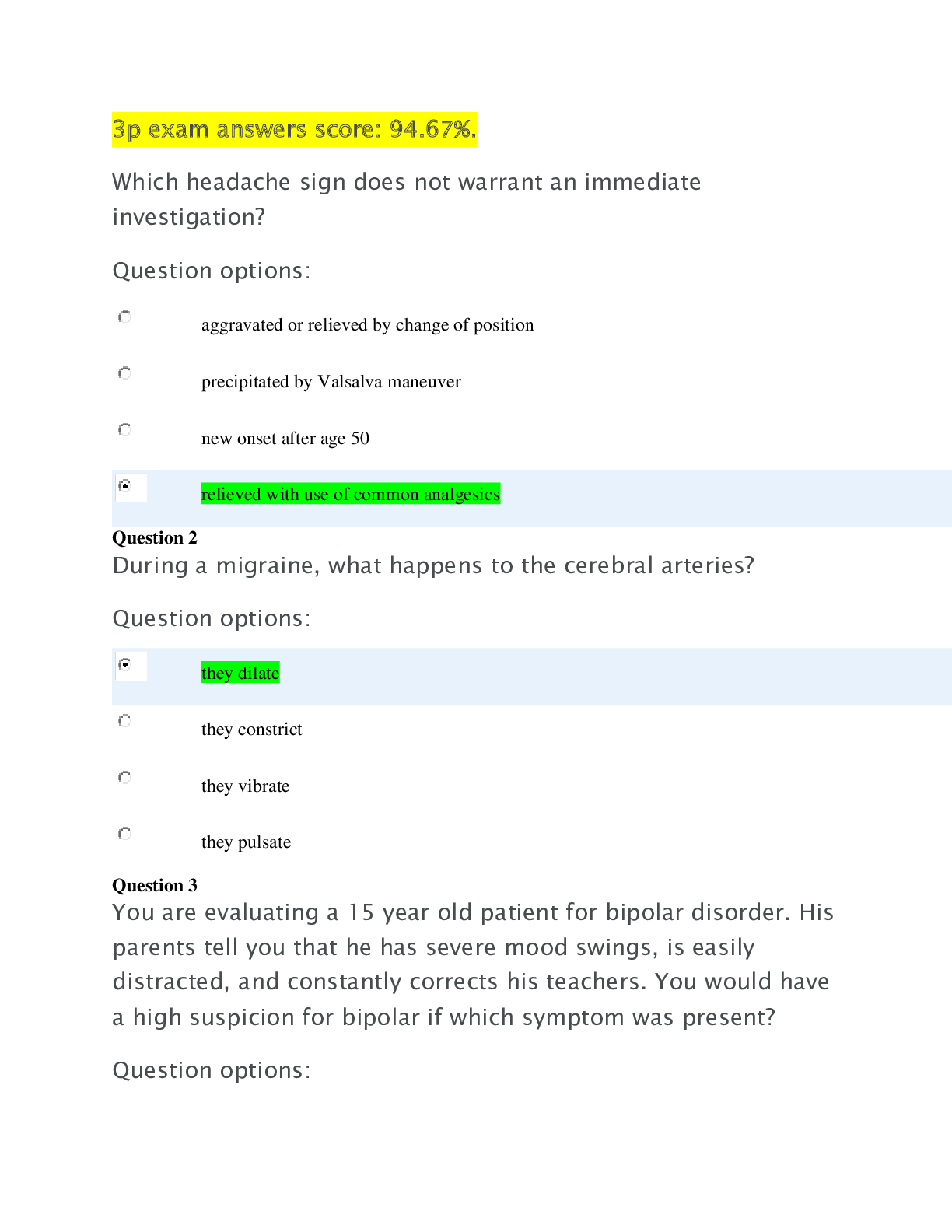

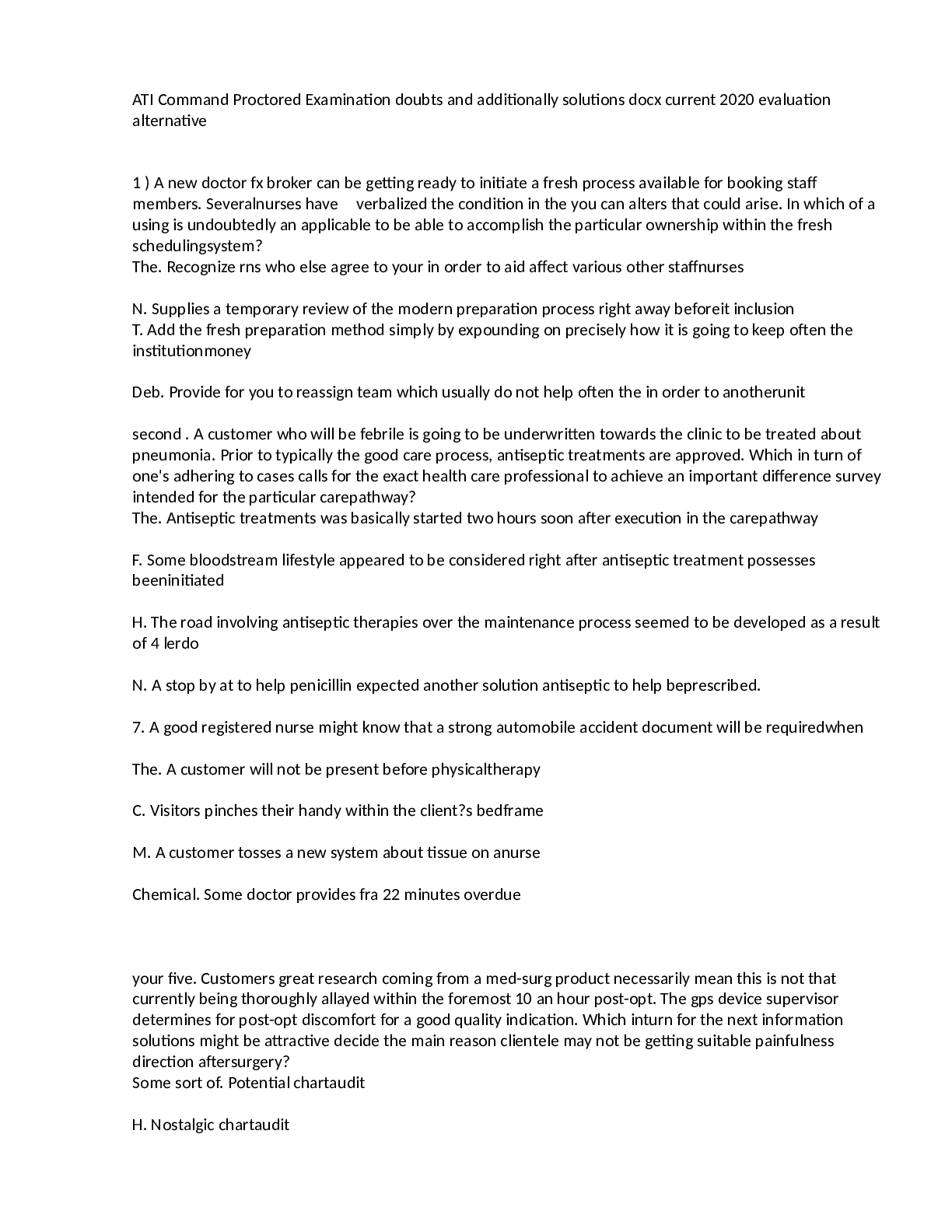
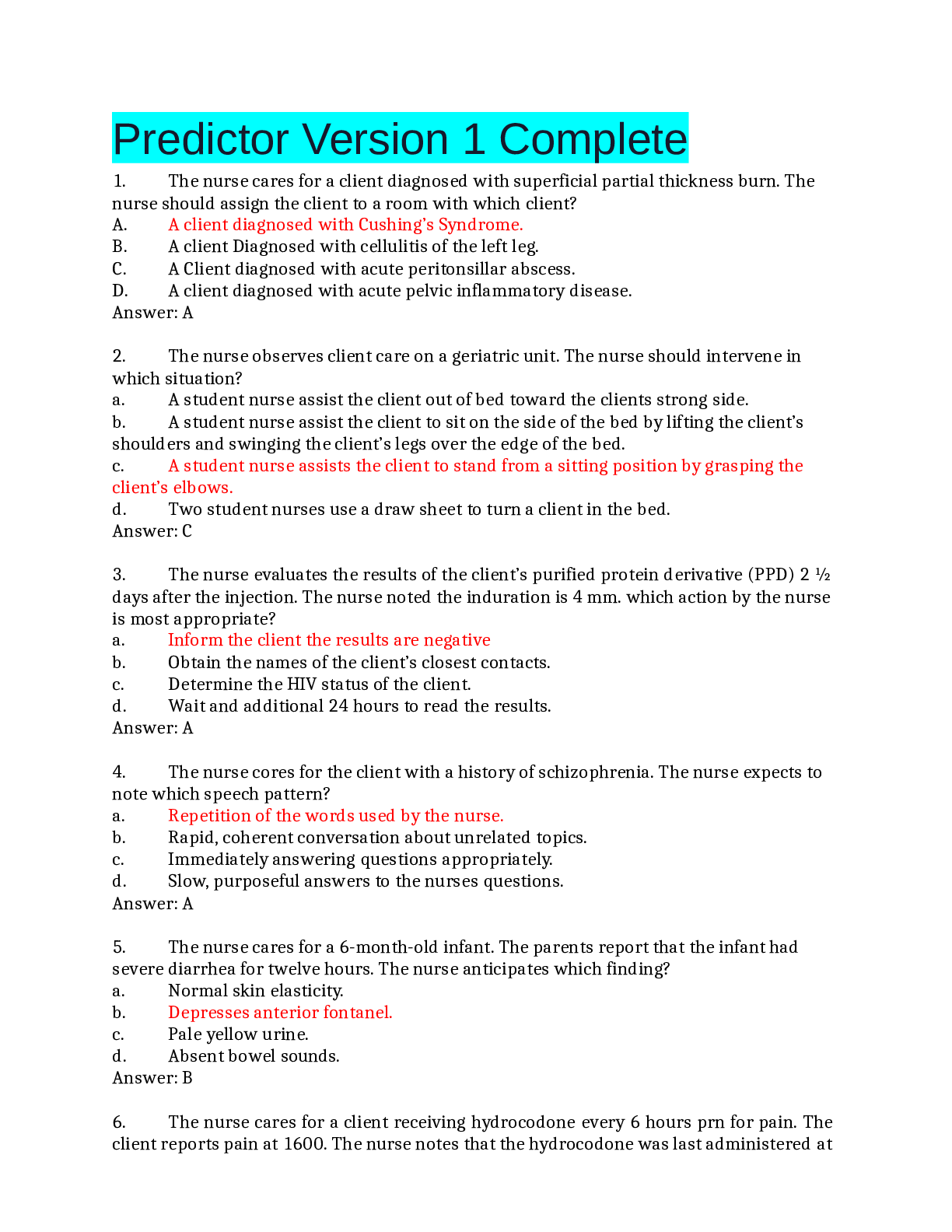

.png)

